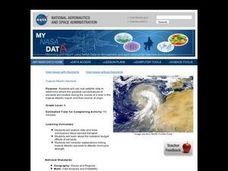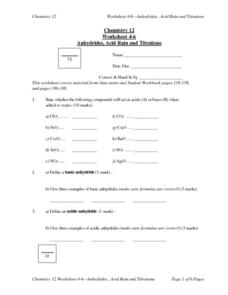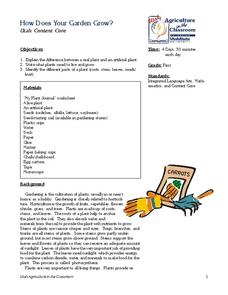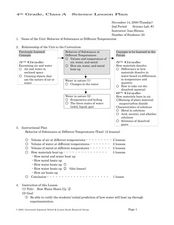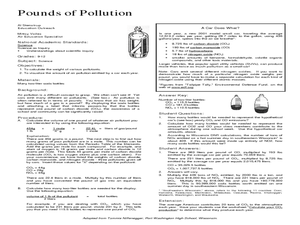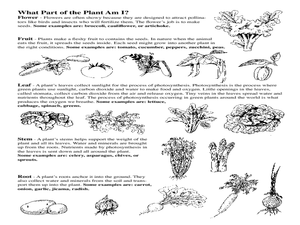Curated OER
The Seven Characteristics of Life
Third graders investigate the characteristics of living and nonliving things. They conduct a research quest in order to identify the seven characteristics of life. Then students pick one aspect and use it to create a song meant to be...
Curated OER
Respiratory System
Students identify elements of the respiratory system. They write notes on cards, diagram the respiratory system and label it. As a class, students discuss the function of each part of the respiratory system and explore the difference...
Curated OER
Troical Atlantic Aerosols
Learners explore the effect aerosols have upon he weather and climate. They observe NASA satellite images to explore and draw conclusions about aerosol transport. From studying the images, students track the path of aerosols. They...
Curated OER
Beaver Ecology
Students explore the lives of bgeahvers. They identify the physical and behavioral adaptations that help beavers survive in their environment. Students compare and contrast how beavers influence the ecology of both forest and aquatic...
Curated OER
Measuring Reaction Rates
In this chemical reaction worksheet, young scholars determine the rate of consumption or rate of production for given reactions. This worksheet has 14 problems to solve.
Curated OER
Anhydrides, Acid Rain and Titrations
In this chemical compounds worksheet, students determine is compounds will act as acids or bases when added to water. Students compare basic, acidic, and amphoteric anhydrides. This worksheet has 15 fill in the blank, 2 short answer...
Curated OER
Chemical Equilibrium
Learners explore Le Chatelier's Principle. In this instructional activity about chemical equilibrium, students do an experiment with several different activities . Learners observe as they do the experiments and understand the outcome....
Curated OER
Food Chains, Food Webs, Biomass Pyramids and Cycle
In this food chains worksheet, students complete a crossword puzzle by placing 16 terms into the puzzle that match the clues given. Students review food webs, biomass pyramids, and the water cycle.
Curated OER
How Does Your Garden Grow?
Students identify what plants need to grow. In this plant biology lesson, students analyze the differences between an artificial plant and a live plant. Students plant seeds and discuss what plants need to grow. Students observe the...
Curated OER
Surface Area to Volume Ratio
Students examine the surface area to volume ratio and how they relate. In this surface area lesson students complete several activities.
Curated OER
How Water Heats Up
Fourth graders conduct experiments heating water. In this inquiry-based early chemistry instructional activity, 4th graders use the materials given to experiment with the process of heating water. Students draw conclusions based upon...
Curated OER
Tropical Atlantic Aerosols
Students analyze NASA data from the Multi-angle Imaging Spectroradiometer. In this NASA data lesson, students access an assigned website to examine information from the MISR on the Terra Satellite. They determine how desert dust travels...
Curated OER
Pond Ecosystem Field Trip
Young scholars investigate the environment by participating in a class trip. In this pond ecosystem lesson plan, students define a list of vocabulary terms associated with ponds such as invertebrate and metamorphosis. Young scholars...
Curated OER
Pounds of Pollution
Students examine pollutants and investigate air pollution emitted by a car in a year. In this air pollution lesson plan students complete an activity and make calculations.
Curated OER
The Energy Debate - Conclusion
Students write a persuasive essay about the choices in the energy debate. They comprehend the environmental consequences that accompany the decision. Students predict how they will power their future.
Curated OER
The Energy Debate - Sea Level Rise
Students comprehend the impact of global warming on our coastal cities. They appreciate how geographic information systems can be used to represent scientific data. Students research the melting of the ice caps in Antarctica and the Arctic.
Curated OER
How Does Radon Affect Human Lungs?
Students identify the different parts of the respiratory system of the human body. They work together to complete an activity and worksheet about the effects of radon on the lungs. They research lung diseases if time permits.
Curated OER
Redwood Trees: How Does Water Get to the Top of the Tree
High schoolers discuss photosynthesis. They explore and discuss surface tension, hydrogen bonding and capillary action with hands on experiments. They make journal entries and draw pictures of the different stages of the experiments.
Curated OER
Plant Party
Students identify plant parts. In this plants instructional activity, students bring in a vegetable. Each student classifies which part of the plant their vegetable comes from (flower, root, ect.) Students identify the parts of their...
Curated OER
What's Making It Look So Brown Outside?
Ninth graders analyze cars and particulate matter in the atmosphere. They analyze results of particulate pollutants and identify which vehicle gives off more particulates. They identify sources of particulate matter and relate to...
Curated OER
It's Okay to Exhale: Photosynthesis and Cellular Respiration
Students will observe the differences between photosynthesis and cellular respiration. Then they observe the links due to climate changes and relate how climate change affects their lives.
Curated OER
De"compost"ition Activity
Students investigate the decomposition process and the parameters which influence the rate at which it occurs. They design a "controlled" experiment by comparing decomposition rates between two compost piles. Analysis questions include...
Curated OER
Anatomy
Second graders identify the major organs of the body and their primary function, identify major systems of the body, and describe behaviors that protect the body structure and organs.
Curated OER
Anatomy
Third graders explore the basic structures and functions of the human body and how they relate to personal health.
Other popular searches
- Carbon Dioxide Oxygen Cycle
- Oxygen, Carbon Dioxide Cycle
- Carbon Dioxide/ Oxygen Cycle
- Oxygen Carbon Dioxide Cycle
- Oxygen Carbon Dioxide Cycle
- Oxygen Carbon Dioxide Cycle
- Air Oxygen Carbon Dioxide
- Carbon Dioxide Oxygen Cycle


